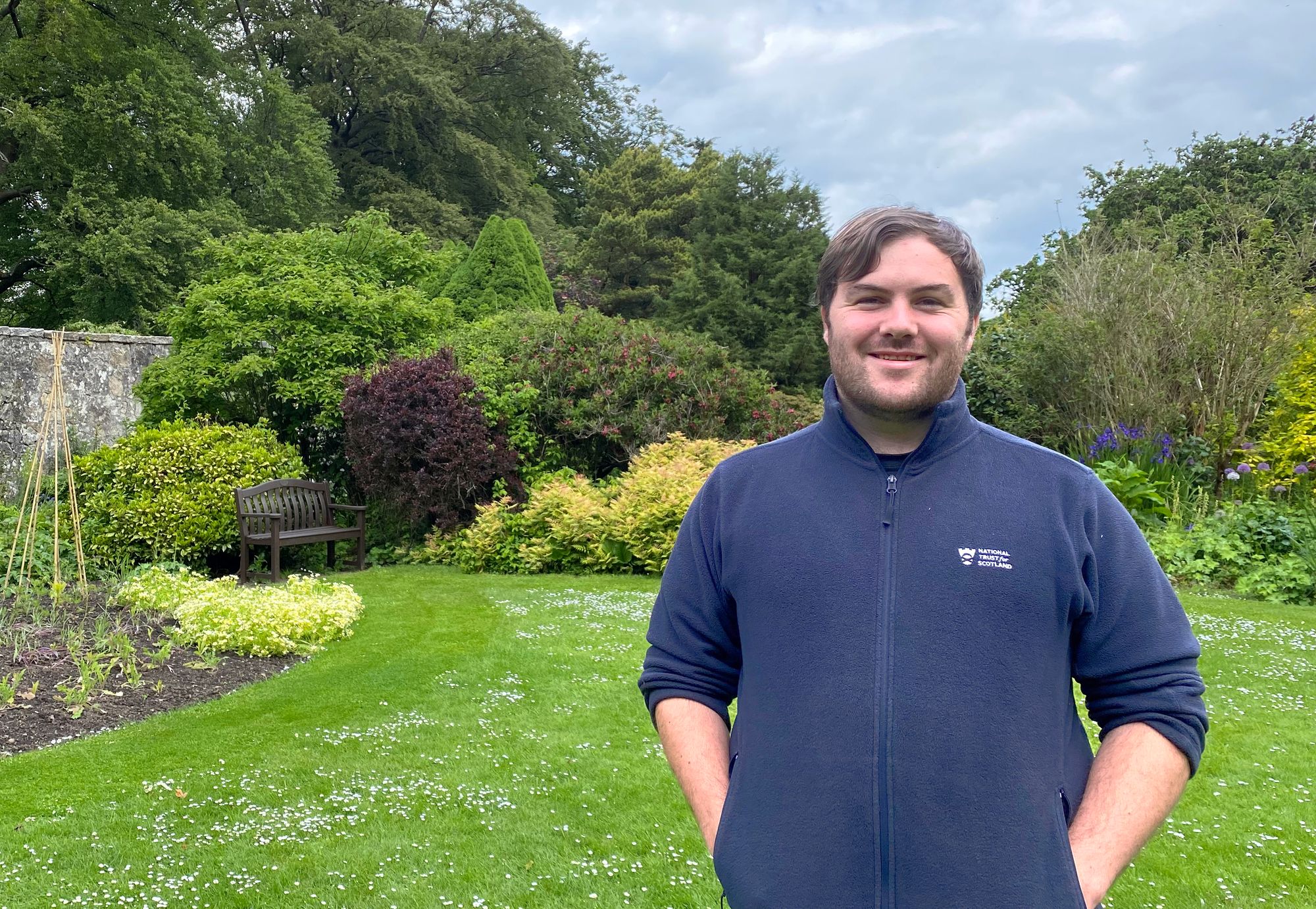Getting started
Andrew’s current role is his second Head Gardener position since completing his BSc in Horticulture with Plantsmanship at SRUC in 2020. After graduation, he worked his way up to Head Gardener for the busy garden maintenance firm, North Hill Gardens, and is now the custodian of the National Trust for Scotland’s Greenbank Garden on the outskirts of Glasgow. Lush paddocks and mature woodland surround the domestic walled garden, which was created in the 1760s, and a series of high hedges divide the walled space into different garden rooms.
This is not my garden. It belongs to the trees, the plants and wildlife, and the visitors. I’m very humbled by everyone who has gathered around to help me work hard for this – I want to do everyone proud.
Andrew and his team are challenging traditional approaches to garden maintenance by using more eco-conscious methods. With the help of two gardeners, around 40 volunteers, an army of slug-eating frogs, several hedgehogs, 12 playful parakeets and over 3,600 species of plants, Andrew’s goal is to create the most eco-friendly garden in the National Trust. To boost the garden’s biodiversity, over 30 new bird boxes and two beehives are in place, and plans for a new wildflower meadow and wildlife pond are coming together. As Andrew says, “This is not my garden. It belongs to the trees, the plants and wildlife, and the visitors. I’m very humbled by everyone who has gathered around to help me work hard for this – I want to do everyone proud.”

Andrew’s daily routine
Checking the schedule
My work day starts at 8 am. The first thing I do after opening up the garden is to look at my plan for the day – I check my list of our week’s tasks to see if we’re on track or if I need to make any changes. We have a whiteboard schedule in the garden bothy, and I update that for both staff and volunteers.
Guiding our volunteers
We have around 40 volunteers working in the garden every week – this is one of the largest volunteer groups in the Trust. I assign a gardener to supervise the volunteers, to make sure they understand what they’re doing and check that their tools are fit for purpose. Today, I’m working with our volunteers to re-edge paths, weed the borders, and veteran prune a Magnolia sieboldii tree infected with honey fungus. The tree is struggling, it’s a real shame. However, rather than going with the usual practice of removing the tree or using fungicides, we’ve decided to cut off a third of its branches every year, to allow new base growth to come through. Hopefully, this will restore it to its former glory, and we won’t lose a wonderful tree.

Heritage management
When a plant is struggling, like the magnolia, we need to make decisions about how to manage it. Another one that requires some consideration is the oldest tree in the garden – an apple tree. It’s completely hollow in the middle, and the parakeets that live in the garden like to slide down the inside! It has the potential to be a health and safety risk as it’s so close to the path, but there’s still healthy growth on it and we get a nice crop of apples from it every year. The tree is from the original apple orchard at the bottom of the garden; we think the variety is Newton’s Grace. It’s been here longer than any other plant, animal, or human. I’m going to do everything I can to make sure it stays up, and I’ll use a support if needs be – this could be a great opportunity to share the tree’s story with our visitors.

Maintenance tasks
On the days that we’re closed to the public, we do our machinery work, like cutting the grass and strimming – mostly using battery-powered machinery. During the COVID-19 lockdowns, the gardening team only cut the grass, so we’re still getting on top of the weeding! For now, we’re focusing on the front of the borders, to give the plant collection room to thrive and grow.
No one at Greenbank has a PA1 or PA6 spraying certificate: instead of pesticides, we use things like electric weed guns, hand weeding, and companion planting to manage pests and weeds. The frogs also lend a hand managing the slugs, especially in the garden room with our national collection of bergenia. The volunteers and students will try most maintenance tasks – but there are some only the staff will do, like trimming the tall hedges or the top of the topiary owl, because these involve working at height.

Mentorship
Visitors often stop and ask us questions about the plants, or about how to manage their soil. We have horticulture students doing their work experience here too, and I love watching their progression. They can use the garden as a resource to improve their horticultural skills, which will increase horticultural expertise in the industry overall.
To me, giving gardening advice is crucial, and I want this to be the kind of place that people come to for expert knowledge.
Historically, Greenbank has been a demonstration garden, with every room displaying a different style of horticulture. Nowadays, we want to show how you can look after a garden with an environmental consciousness, and share that expertise along the way. To me, giving gardening advice is crucial, and I want this to be the kind of place that people come to for expert knowledge.
🌿 Andrew’s top tip for aspiring head gardeners
Practical experience is key. I’ve worked really hard to get where I am – I dedicated myself to education while also keeping up my practical skills through part-time work and volunteering. It’s really important to have practical skills in horticulture: in fact, it’s half the battle. I know people with the same degree as me, who are struggling to find a job because they don’t have hands-on experience. A lot of people steer away from volunteering too, some think it’s not worth their time. But some of our volunteers at Greenbank Garden only come for a few hours here or there – that’s all it takes to get practical experience on your CV.
Spreading the word
I often host visitors to the garden. Yesterday, I gave a group of around 25 garden design students from the SRUC a tour. We’re also trying to do more to promote the garden: we’re upping our game with our social media, and I recently recorded a podcast with the broadcaster Jackie Bird, which was great fun.
Afternoon admin
I save most of my admin tasks for the afternoon. Having competent, qualified gardeners on site means that I can step away and leave them to look after the volunteers or get on with tasks. I know head gardeners can often become swamped in admin, but I’m lucky that I don’t have too much – my time split is probably around 70 per cent practical tasks, and 30 per cent admin. The kind of admin tasks I deal with include meetings with National Trust managers, planning projects, and recruitment. I recently advertised two seasonal gardener roles, and processing these applications kept me busy!
Related articles
Does Andrew's job sound ideal for you? Check out these horticulture articles next!
🌻 Are you thinking of a career in horticulture, or do you want to improve your existing skills and experience? Find vacancies and training courses here.

